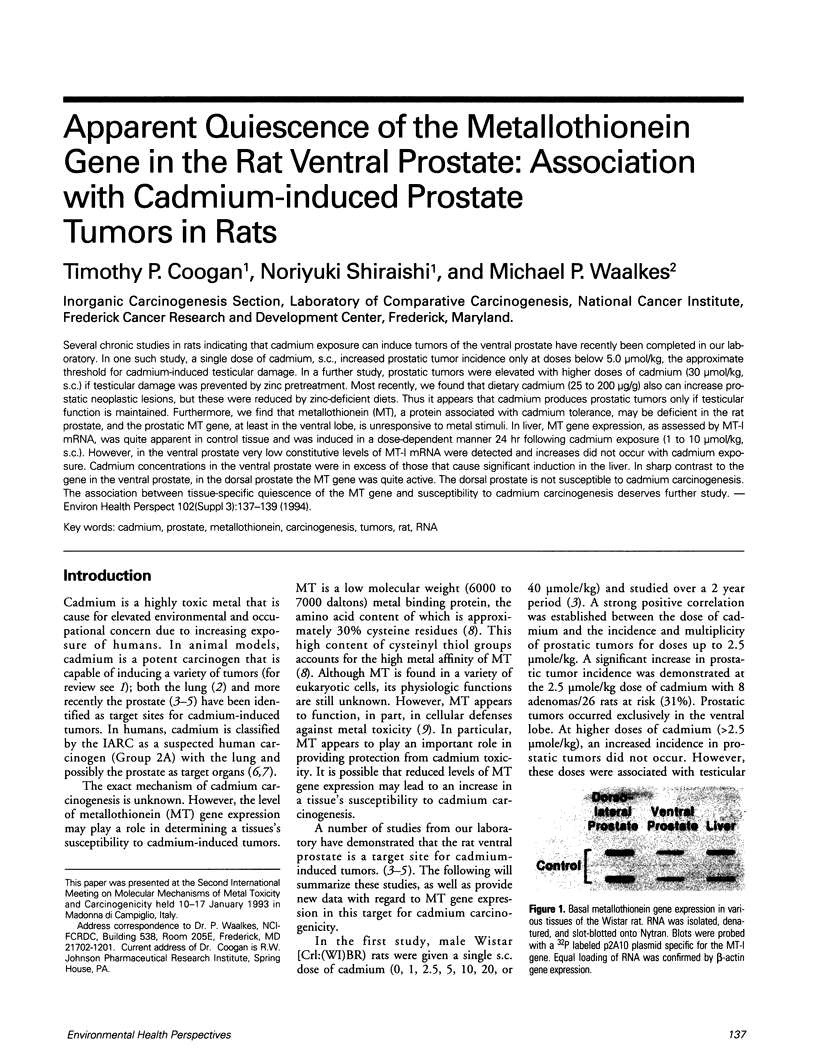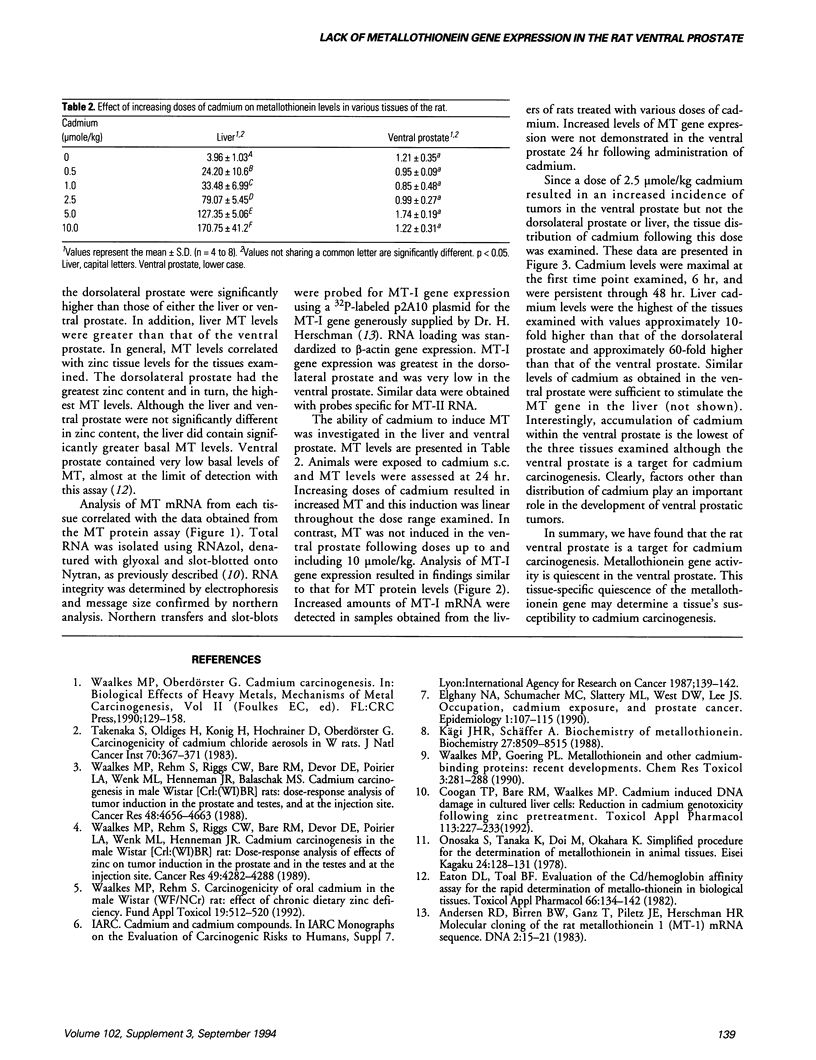Abstract
Several chronic studies in rats indicating that cadmium exposure can induce tumors of the ventral prostate have recently been completed in our laboratory. In one such study, a single dose of cadmium, s.c., increased prostatic tumor incidence only at doses below 5.0 mumol/kg, the approximate threshold for cadmium-induced testicular damage. In a further study, prostatic tumors were elevated with higher doses of cadmium (30 mumol/kg, s.c.) if testicular damage was prevented by zinc pretreatment. Most recently, we found that dietary cadmium (25 to 200 micrograms/g) also can increase prostatic neoplastic lesions, but these were reduced by zinc-deficient diets. Thus it appears that cadmium produces prostatic tumors only if testicular function is maintained. Furthermore, we find that metallothionein (MT), a protein associated with cadmium tolerance, may be deficient in the rat prostate, and the prostatic MT gene, at least in the ventral lobe, is unresponsive to metal stimuli. In liver, MT gene expression, as assessed by MT-1 mRNA, was quite apparent in control tissue and was induced in a dose-dependent manner 24 hr following cadmium exposure (1 to 10 mumol/kg, s.c.). However, in the ventral prostate very low constitutive levels of MT-1 mRNA were detected and increases did not occur with cadmium exposure. Cadmium concentrations in the ventral prostate were in excess of those that cause significant induction in the liver. In sharp contrast to the gene in the ventral prostate, in the dorsal prostate the MT gene was quite active. The dorsal prostate is not susceptible to cadmium carcinogenesis.(ABSTRACT TRUNCATED AT 250 WORDS)
Full text
PDF


Images in this article
Selected References
These references are in PubMed. This may not be the complete list of references from this article.
- Andersen R. D., Birren B. W., Ganz T., Piletz J. E., Herschman H. R. Molecular cloning of the rat metallothionein 1 (MT-1) mRNA sequence. DNA. 1983;2(1):15–22. doi: 10.1089/dna.1.1983.2.15. [DOI] [PubMed] [Google Scholar]
- Coogan T. P., Bare R. M., Waalkes M. P. Cadmium-induced DNA strand damage in cultured liver cells: reduction in cadmium genotoxicity following zinc pretreatment. Toxicol Appl Pharmacol. 1992 Apr;113(2):227–233. doi: 10.1016/0041-008x(92)90118-c. [DOI] [PubMed] [Google Scholar]
- Eaton D. L., Toal B. F. Evaluation of the Cd/hemoglobin affinity assay for the rapid determination of metallothionein in biological tissues. Toxicol Appl Pharmacol. 1982 Oct;66(1):134–142. doi: 10.1016/0041-008x(82)90068-0. [DOI] [PubMed] [Google Scholar]
- Elghany N. A., Schumacher M. C., Slattery M. L., West D. W., Lee J. S. Occupation, cadmium exposure, and prostate cancer. Epidemiology. 1990 Mar;1(2):107–115. doi: 10.1097/00001648-199003000-00005. [DOI] [PubMed] [Google Scholar]
- Kägi J. H., Schäffer A. Biochemistry of metallothionein. Biochemistry. 1988 Nov 15;27(23):8509–8515. doi: 10.1021/bi00423a001. [DOI] [PubMed] [Google Scholar]
- Takenaka S., Oldiges H., König H., Hochrainer D., Oberdörster G. Carcinogenicity of cadmium chloride aerosols in W rats. J Natl Cancer Inst. 1983 Feb;70(2):367–373. [PubMed] [Google Scholar]
- Waalkes M. P., Goering P. L. Metallothionein and other cadmium-binding proteins: recent developments. Chem Res Toxicol. 1990 Jul-Aug;3(4):281–288. doi: 10.1021/tx00016a001. [DOI] [PubMed] [Google Scholar]
- Waalkes M. P., Rehm S. Carcinogenicity of oral cadmium in the male Wistar (WF/NCr) rat: effect of chronic dietary zinc deficiency. Fundam Appl Toxicol. 1992 Nov;19(4):512–520. doi: 10.1016/0272-0590(92)90089-z. [DOI] [PubMed] [Google Scholar]
- Waalkes M. P., Rehm S., Riggs C. W., Bare R. M., Devor D. E., Poirier L. A., Wenk M. L., Henneman J. R., Balaschak M. S. Cadmium carcinogenesis in male Wistar [Crl:(WI)BR] rats: dose-response analysis of tumor induction in the prostate and testes and at the injection site. Cancer Res. 1988 Aug 15;48(16):4656–4663. [PubMed] [Google Scholar]
- Waalkes M. P., Rehm S., Riggs C. W., Bare R. M., Devor D. E., Poirier L. A., Wenk M. L., Henneman J. R. Cadmium carcinogenesis in male Wistar [Crl:(WI)BR] rats: dose-response analysis of effects of zinc on tumor induction in the prostate, in the testes, and at the injection site. Cancer Res. 1989 Aug 1;49(15):4282–4288. [PubMed] [Google Scholar]




